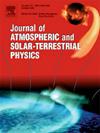由DSX卫星传输的哨声模式波的传播
IF 1.9
4区 地球科学
Q3 GEOCHEMISTRY & GEOPHYSICS
Journal of Atmospheric and Solar-Terrestrial Physics
Pub Date : 2025-05-15
DOI:10.1016/j.jastp.2025.106530
引用次数: 0
摘要
在DSX卫星上进行了极低频(300 ~ 3000 Hz)哨声模波的发射与接收实验。在一些情况下,发射的波在几百毫秒的时间延迟后才被卫星上的同一天线接收。这些事件表明,发射波主要沿着周围的磁场传播,在路径上的某个位置反射,然后返回卫星。与这些观测有关的主要问题是:(1)是什么原因导致波沿着周围磁场引导?(2)这些波在磁层的什么地方被反射?本文的分析和数值研究结果表明,波是由场向密度不均匀性(即管道)引导的,并从管道的末端反射。本文章由计算机程序翻译,如有差异,请以英文原文为准。
Propagation of whistler-mode waves transmitted by the DSX satellite
Experiments consisting of the transmission and receiving of ELF (300-3000 Hz) whistler-mode waves were conducted on board of DSX satellite. In several events, the transmitted waves were received by the same antenna on the satellite after a time delay of several hundred milliseconds. These events suggest that the transmitted waves propagate mostly along the ambient magnetic field, reflect at some location along their path, and return back to the satellite. The main questions related to these observations are: (1) What causes the guiding of the waves along the ambient magnetic field? and (2) Where in the magnetosphere are these waves reflected? The results from analytical and numerical studies presented in this paper indicate that the waves are guided by the field-aligned density inhomogeneities (aka ducts), and they are reflected from the ends of the duct.
求助全文
通过发布文献求助,成功后即可免费获取论文全文。
去求助
来源期刊

Journal of Atmospheric and Solar-Terrestrial Physics
地学-地球化学与地球物理
CiteScore
4.10
自引率
5.30%
发文量
95
审稿时长
6 months
期刊介绍:
The Journal of Atmospheric and Solar-Terrestrial Physics (JASTP) is an international journal concerned with the inter-disciplinary science of the Earth''s atmospheric and space environment, especially the highly varied and highly variable physical phenomena that occur in this natural laboratory and the processes that couple them.
The journal covers the physical processes operating in the troposphere, stratosphere, mesosphere, thermosphere, ionosphere, magnetosphere, the Sun, interplanetary medium, and heliosphere. Phenomena occurring in other "spheres", solar influences on climate, and supporting laboratory measurements are also considered. The journal deals especially with the coupling between the different regions.
Solar flares, coronal mass ejections, and other energetic events on the Sun create interesting and important perturbations in the near-Earth space environment. The physics of such "space weather" is central to the Journal of Atmospheric and Solar-Terrestrial Physics and the journal welcomes papers that lead in the direction of a predictive understanding of the coupled system. Regarding the upper atmosphere, the subjects of aeronomy, geomagnetism and geoelectricity, auroral phenomena, radio wave propagation, and plasma instabilities, are examples within the broad field of solar-terrestrial physics which emphasise the energy exchange between the solar wind, the magnetospheric and ionospheric plasmas, and the neutral gas. In the lower atmosphere, topics covered range from mesoscale to global scale dynamics, to atmospheric electricity, lightning and its effects, and to anthropogenic changes.
 求助内容:
求助内容: 应助结果提醒方式:
应助结果提醒方式:


